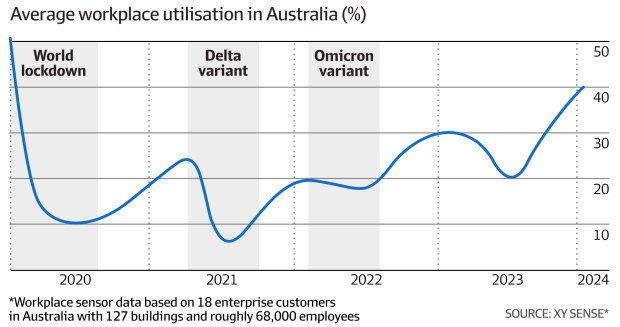Golf ranges are booming on weekdays. Welcome to the WFH economy
Most office workers are now splitting their workdays between home and the office. Remote working is changing the way we live and do business.
Back in 2019, before the pandemic, on any given weekday only about half of the golf bays at Golf Central, a driving range and mini golf complex near Brisbane Airport, were occupied during work hours.
These days occupancy during work hours between Monday and Friday is closer to 80 per cent, says James Cooper, founder and managing director of Avid Sports Management, an operator of driving ranges.
The increase has prompted Cooper to double the number of golf bays to 54 as part of an extensive expansion project that also includes building a 400-seat brewery and gin and vodka distillery and a second mini golf course.

“Traditional office hours are a lot busier these days,” says James Cooper. Jamila Toderas
“It’s been tremendous. Traditional office hours are a lot busier these days,” Cooper says of the uplift in business, adding the trend has surprised him.
“I thought we might see golf soften [after the COVID-19 pandemic] but it hasn’t,” Cooper tells AFR Weekend. He says “a lot more professionals”, as well as tradies, are visiting the driving range during work hours.
The new work-from-home economy
It all comes back to the pandemic shift to working from home. Although the five-day weekly commute remains the norm in some workplaces, research suggests most office workers today spend at least some of their working week at home. Squeezing in trips to the driving range during work hours has become feasible for large swathes of the workforce. And it’s not just driving ranges that have benefited from the trend. Hairdressers, physiotherapists, personal trainers and dentists have seen a boost, too.
Not everyone is happy about the surge in remote working, though. Many bosses believe that working from home makes it harder for employees and new starters in particular to build connections with and learn from their colleagues. Commonwealth Bank chief executive Matt Comyn, for example, echoed the views of many banking leaders last year when he said, “people who are new to the organisation are more successful when they’re spending more of their time in the office”. All the big four banks require their staff to spend either 50 per cent of their time each month, or two to three days each week, in the office at a minimum.
Some organisations have even gone as far as tying time in the office to bonuses and annual performance reviews. The Australian Financial Review was the first to report last year, for example, that Origin Energy and Suncorp Group had taken this route. ANZ followed suit in November, drawing plenty of fire from the Finance Sector Union as a result, and energy giant AGL did the same in January.
It is unclear whether these policies directly led to an increase in office attendance.
But workplace sensor data from XY Sense suggests that workers spent more time at their desks in the first three months of this year than they had done during any quarter since the pandemic. Average office utilisation was 40 per cent in the first quarter of 2024, up nine percentage points on that recorded in the third quarter of last year.

Average office utilisation in Australia has reached its highest level since February 2020, according to XY Sense data. Financial Review
Job security fears drive office uptick
XY Sense co-founder Alex Birch and Productivity Commission chair Danielle Wood link the trend to the softening jobs market. “The pendulum has moved towards the employer, and therefore people feel more obliged to go back into work,” Birch says, referring to a rising wave of redundancies sweeping through corporate Australia.
Bosses will no doubt hope more bums on seats lead to greater productivity, even if the evidence on that point is mixed, while business owners will have to keep alert to further shifts in working patterns to ensure their offerings match the needs of their customers.
Renee Schembri, owner of Status Co, a hair salon in Sydney’s Barangaroo office district, is hoping the uptick in office attendance will help drive more business to the salon.
So far, Schembri has seen a pick-up in midweek trade as more companies demand staff come back to the office and as those staff retain a degree of flexibility while complying with such directives.
“With [the move to] flexibility, we’re seeing people coming in and sitting there with their laptop and getting their hair done at the same time,” Schembri says.
“They come to us and spend three or four hours having a cut and colour, and they’ll sit there tapping away at the laptop, doing their work. They’re not chewing up their family time, or their own time, on the weekend, which seems to be a smarter way of working these days. They are definitely still working during those Monday to Friday times.”
The entrepreneur has also noticed clients from the same company come to the salon and have a meeting. Happily, the salon offers free tea, coffee and soft drinks and can arrange lunch from a local takeaway to be delivered. There is also a full bar service.
“You find a couple of colleagues might actually have a meeting while getting their hair or their blow dry done. If it is late in the afternoon, it might be with a glass of champagne or a glass of wine, and they take that formality out of it,” Schembri says.
‘Good news for service businesses’
Jessica Rozen, economist and director of Economic Insights at consulting firm Accenture, says the trend towards people working from home has helped businesses such as hairdressers, physiotherapists, personal trainers and dentists by enabling them to spread their work more evenly and minimise bottlenecks because clients are no longer only available outside traditional work hours.
“Whether explicit or implicit, [after COVID] we struck a new working bargain. If you’re getting the work done, on time, and to the expected standard, some employers became more willing to give you flexibility on the when and where [you work],” Rozen says.
“This opened new opportunities for service businesses with bottlenecks. All of a sudden, it became feasible to go to the post office at 2pm, or see the dentist at 10am.
“While demand still has peaks outside of working hours, they are less pronounced. It’s good news for service businesses that are supply constrained. It creates opportunities to take on more clients, and grow.”
It’s not a good news story for everyone. Simon Brown, manager of Melbourne Bicycles, a retailer in the inner-northern suburb of Clifton Hill, says he’s had to cut back on mechanic hours because the working-from-home trend has led to fewer commutes.
“People are not commuting as many days as they were, and the bikes are not getting as big a workout,” Brown says, while also noting he has observed an increase in ebike sales.
“We have two mechanics on each day, whereas pre-COVID we had three people on for three days, and two on for two days.”
‘Not tearing my hair out’
One of the big questions around work from home is what it means for productivity. It’s common to hear executives and other business types claim employees are much more productive when working with others in the office. But it often feels like every research paper that concludes remote working is bad for productivity is matched by one that finds the opposite.

Simon Brown has cut back on mechanic hours at his bicycle shop in Melbourne. Elke Meitzel
A study by Australian academics last year, for example, found that each additional day an employee worked from home per week in 2022 – up until the fifth day – led to a corresponding deterioration in productivity, efficacy, turnover intentions, depression, anxiety and loneliness.
But research by the Bank of England, as reported by the Financial Times this year, found that, for every extra day an employee worked outside the office, their productivity rose to the tune of about £15,000 ($29,000) a year.
Productivity Commission boss Danielle Wood says the balance of evidence suggests there is no productivity gain or loss from hybrid work, but a negative effect from purely remote work.
“I am not in any way tearing my hair out over this trend. It looks to me to be overall benign, but obviously, it will depend on how well we manage it and continue to hit that sweet spot,” she tells AFR Weekend.
Having fewer opportunities to interact with colleagues face-to-face is working from home’s biggest downside in Wood’s eyes.
“That’s knowledge spillovers. You share information, you have the fortuitous conversations. There’s the learning and development that goes on for junior staff in the office, and there is some research which suggests that that is something that can get lost when people work remotely.”
Meanwhile, Wood reckons the main benefits are the opportunities for people to structure their work more flexibly, and to operate in an environment where it may be easier to concentrate.
“The other big benefit is the cost of commuting,” she says, “Particularly in major cities in Sydney and Melbourne, both the time and financial cost is very real. The chance to avoid that two or three days a week produces a very real social and economic benefit.”
The future
As for what happens next, Wood expects offices to become more crowded as workers seek to improve their chances of surviving the next round of corporate redundancies. And XY Sense co-founder Alex Birch agrees.
“Offices are going to get busier, but they will be smaller,” Birch says, noting that two or three days a week in the office has replaced five days a week as corporate Australia’s new workplace standard. (Survey data from the Australian HR Institute shows that employers requiring staff to attend the office three days a week is the most popular hybrid arrangement.)
“As leases [come] up for renewal, organisations will right-size to align with demand and redesign to support today’s hybrid ways of working,” Birch says.
That could involve swapping out large boardrooms for one or two-person meeting rooms, given new working patterns mean many attendees will now just dial in. And it could even mean temporarily deactivating floors to save on energy costs, a strategy that XY Sense is helping clients with but one that is difficult to implement.
“It is a complex problem,” Birch says. “It’s one that needs to be solved, because if the three-day [in-office] workweek is the future, we do need to rethink how we leverage offices for energy purposes.”
Subscribe to gift this article
Gift 5 articles to anyone you choose each month when you subscribe.
Subscribe nowAlready a subscriber?
Introducing your Newsfeed
Follow the topics, people and companies that matter to you.
Find out moreRead More




Latest In Workplace
Fetching latest articles